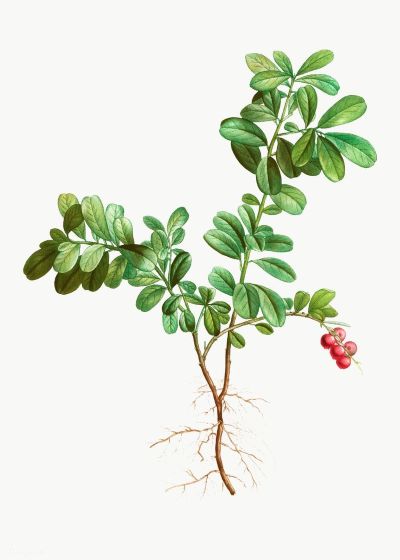Cranberry
- Description of Cranberry
- Distribution and Ecology of Cranberry
- Raw Materials from Cranberry
- Chemical Composition of Cranberry
- Effects and Applications of Cranberry
- Precautions for Using Cranberry
- Contraindications for Using Cranberry
- Recipes with Cranberry
- Cosmetics from Cranberry
- Culinary Uses of Cranberry
Cranberry
Vaccinium oxycoccos L.
Ericaceae Family
Description of Cranberry
Cranberry is an evergreen creeping shrub, 10–50 cm, with thin, thread-like stems. Leaves alternate, small, 5–10 mm, leathery, dark green, whitish below. Flowers pink or reddish, 5–7 mm, solitary or in small clusters (2–4 flowers). Fruits round berries, 8–16 mm, red, sour, with small seeds. Varieties: ‘Ben Lear’, ‘Stevens’, ‘Pilgrim’. Flowering in June–July, fruiting in September–October.
Distribution and Ecology of Cranberry
Cranberry grows in Northern Europe, Siberia, Far East, North America, on bogs, peatlands, tundra, up to 2000 m above sea level. Cultivated in Russia, Finland, Canada, USA. Prefers acidic, moist soils (pH 3.0–5.0), partial shade, watering 10–15 L/m² every 7–10 days. Propagated by seeds, cuttings, bush division. Yield: 0.5–2 kg/m². Care: mulching, feeding with sulfur (10–15 g/m²), protection from gray mold, weevils. Used in landscaping boggy areas, as honey plant.
Raw Materials from Cranberry
Raw materials: fruits (fructus Vaccinii oxycocci), leaves (folia Vaccinii oxycocci). Fruits harvested in September–October, dried at 40–50 °C (yield 15–20%). Leaves harvested in June–July, dried at 40 °C (yield 15–20%). Quality: fruits red, mold-free; leaves green; moisture ≤12%. Store in airtight containers (fruits: 1 year; leaves: 1 year). Aroma weak, taste sour.
Chemical Composition of Cranberry
Fruits: water (88%), sugars (up to 4%), organic acids (citric, benzoic, up to 3%), pectins (up to 1.5%), vitamin C (up to 40 mg%), A, E, K, flavonoids, anthocyanins, minerals (K, Mn, Fe). Leaves: flavonoids, tannins (up to 3%), vitamin C (up to 60 mg%). Calorie content of fruits: 25–30 kcal/100 g (fresh), 150–200 kcal/100 g (dried).
Effects and Applications of Cranberry
Cranberry has antibacterial, anti-inflammatory, diuretic, antioxidant, tonic effects. Used for urinary tract infections, colds, anemia, hypertension, gastritis, gum diseases. Fruits prevent bacterial infections, strengthen immunity, improve digestion. Leaves help with throat inflammations, skin irritations. Juice reduces fever, strengthens vessels.
Precautions for Using Cranberry
Consumption >500 g/day fresh or >100 g/day dried fruits may cause stomach irritation, diarrhea. Store juice at 0–5 °C no longer than 24 hours. Give children under 3 years ≤30 g/day fruits. Avoid combination with anticoagulants (enhanced effect). Wash berries thoroughly due to pesticides. Prolonged use of leaf infusions (>2 weeks) requires doctor's supervision.
Contraindications for Using Cranberry
Allergy to Ericaceae, gastritis with high acidity, gastric ulcer in exacerbation, urolithiasis, taking anticoagulants, pregnancy, lactation.
Recipes with Cranberry
- Juice for Urinary Tract Infections. Squeeze 100 g fresh fruits, dilute with 100 ml water, drink 50 ml 2 times a day, 7 days.
- Leaf Infusion for Colds. Pour 10 g leaves with 200 ml boiling water, infuse 20 min, drink 50 ml 2 times a day, 5 days.
- Fruit Decoction for Anemia. Boil 30 g dried fruits in 200 ml water 10 min, drink 50 ml 3 times a day, 10 days.
- Compresses for Skin Inflammations. Apply 20 g fruit pulp for 15 min, rinse, 2 times a day, 5 days.
Cosmetics from Cranberry
Cranberry is used for skin care.
- Rejuvenating Mask. 20 g fruit pulp, 10 ml honey, apply for 15 min, rinse, 2 times a week.
- Lotion for Oily Skin. 20 ml juice, 10 ml water, wipe skin, 1 time a day.
- Moisturizing Mask. 20 g pulp, 10 ml yogurt, apply for 20 min, rinse, 2 times a week.
- Leaf Infusion for Acne. Pour 10 g leaves with 100 ml boiling water, infuse 20 min, wipe skin, 2 times a day.
Culinary Uses of Cranberry
Fruits used fresh, dried, in drinks, desserts.
- Morse. 200 g fresh fruits, 1 L water, 50 g sugar, boil 10 min, strain.
- Jam. 1 kg fruits, 800 g sugar, 200 ml water, boil 30 min, store in jars.
- Sauce for Meat. 200 g fruits, 50 g sugar, 10 ml vinegar, boil 15 min.
- Smoothie. 200 g fruits, 100 ml yogurt, 10 g honey, blend.
Tips: Store fresh fruits at 0–5 °C up to 3 months, dried up to 1 year. Freeze for long-term storage.
Other Properties of Cranberry
Used in bog landscaping, as honey plant, for soil reinforcement.




